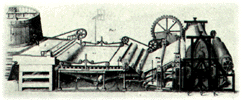
The history of pulp and paper in Canada
Pre-Columbian times-19th century

 Canada's indigenous peoples use forests as a source of energy, building
materials and medicine. The forest also serves an important function in
religious ritual. By the 18th century, Canada's forests are a source of
timber used mainly in ship-building.
Canada's indigenous peoples use forests as a source of energy, building
materials and medicine. The forest also serves an important function in
religious ritual. By the 18th century, Canada's forests are a source of
timber used mainly in ship-building.
19th century
New craft of paper-making revolutionizes industry.
 1803-05
1803-05
First Canadian paper mill built at St. Andrews, Argenteuil County,
Quebec by Walter Ware and Benjamin Wales, two New Englanders. They
manufacture writing, printing and wrapping papers.
1817-23
First of many paper mills in Portneuf County, Quebec, built by Artemus
Jackson, one of the original partners in the Argenteuil mill.
1819
First paper mill in the Maritimes built near Halifax by Anthony Holland,
to supply his newspaper with paper.
1827
First paper mill in Ontario started up by James Crooks near Dundas. A
few months later, in Don Valley (Toronto), a mill run by John Eastwood
and Colin Skinner begins production.
1830s
 Charles Fenerty of Nova Scotia makes the first groundwood paper in the
Western Hemisphere, although not commercially.
Charles Fenerty of Nova Scotia makes the first groundwood paper in the
Western Hemisphere, although not commercially.
1864
First chemical wood pulp mill in Canada built at Windsor Mills, Quebec
using the soda process, by William Angus and Thomas Logan. Their pulp is
used mostly for wrapping papers.
1869
 First groundwood pulp produced commercially in Canada at Valleyfield,
Quebec.
First groundwood pulp produced commercially in Canada at Valleyfield,
Quebec.
1894
First pulp and paper mill in British Columbia started up by William
Hewartson and Herbert Carmichael at Alberni on Vancouver Island.
1901
In Canada there are now 53 mills employing 6,236 people with an annual
value of production of $8.6 million. These plants are, for the most
part, small converting mills making a wide variety of products including:
writing paper, newsprint, books, wrapping and bag papers, board and
building papers.
1913
The U.S. government, having lowered the tariff on newsprint in 1909, now
removes it altogether, giving stimulus to the growth of the newsprint
industry in Canada.
1913
Canadian Pulp and Paper Association forms: Now the Forest Product
Association of Canada.
1918
For the first time, the pulp and paper industry generates more than $100
million in revenues for the Canadian economy. Canada becomes the world's
largest exporter of paper.
1920s
Expansion of the Canadian industry continues and the great papermaking
centres of North Western Ontario and Quebec's St. Maurice Valley, Ottawa
Valley and Lac-Saint-Jean regions experience rapid growth. In 1926,
Canada's newsprint production exceeds that of the U.S. for the first
time.
1930s
Production of pulp and paper in Canada declines by one third in volume
and one half in value as the great depression strikes.
1940s
After the output restrictions of the war end, companies adjust to
peacetime operation. Output rises sharply, by 1950 reaching 9 million
short tons, worth $950 million.
 1960s
1960s
Industry-sponsored Pulp and Paper Research Institute of Canada (PPRIC)
develops twin-wire former, a quantum leap in technology resulting in
faster and more energy-efficient paper production.
1964 to 1969
 Industry boom leads to construction of new mills across Canada,
especially in B.C.
Industry boom leads to construction of new mills across Canada,
especially in B.C.
In 1964, world production of paper and paperboard exceeds 100 million
short tons for the first time.
1970s
Increased international competition and environmental concerns lead to
the development of new, more energy-efficient and
environmentally-friendly technologies.
The 70s are marked by high interest rates and slower economic growth.
Nevertheless, in 1979, the industry produces 20 million metric tons of
pulp, paper and paperboard, valued at over $8 billion.
1989-today
 Between 1989 and today, Canadian mills respond to increasing
environmental challenges by earmarking more than $6 billion for
environmental improvements. During the same period, the industry
invested $1.7 billion in the capacity to recycle recovered paper, making
Canada a leading producer of high quality, recycled content paper
products.
Between 1989 and today, Canadian mills respond to increasing
environmental challenges by earmarking more than $6 billion for
environmental improvements. During the same period, the industry
invested $1.7 billion in the capacity to recycle recovered paper, making
Canada a leading producer of high quality, recycled content paper
products.
Up to now , the industry has spent over $6 billion on new technology
and equipment to reduce emissions and effluent wastes. It added
significant recycling capacity to its mills and has embarked on a $88
million research project to develop closed-cycle technologies. If
successful, these will virtually eliminate pollution and be applied to
all types of mills.
Today
Canada's forest products industry is now a $53 billion business directly
and indirectly employing more than 1 million people. It is also the
biggest net contributor to Canada's international trade balance - $36.8
billion - a figure which represents about two times that of the next
largest sector.
|